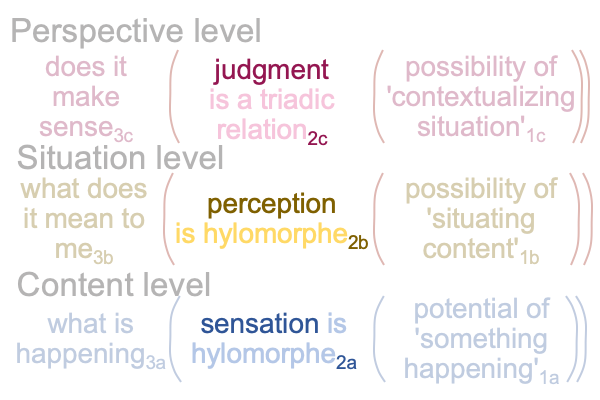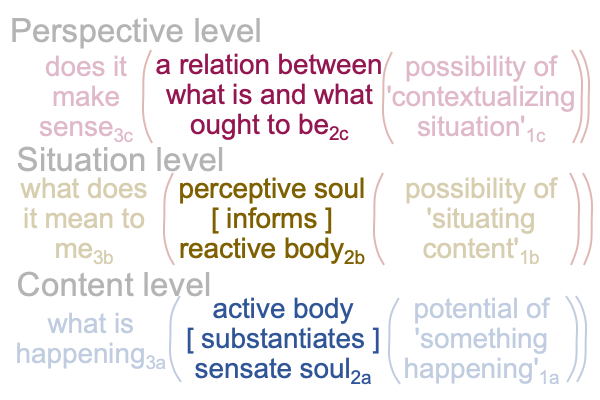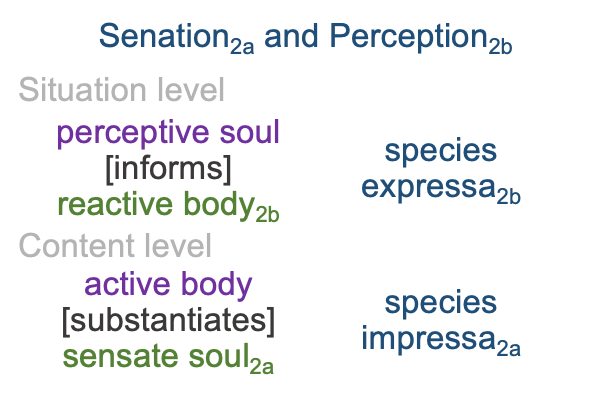0345 Explicit abstractions?
Let me step back and consider how the medieval scholastic interscope for how humans think presents explicit abstractions within a framework that promotes… um… implicit abstraction.
0346 The written words that go into each slot in the scholastic interscope are explicit abstractions.
However, the purely relational structure of the interscope characterizes the nature of implicit abstraction.
0347 To start, the medieval scholastics identify three actualities, corresponding to judgment2c, perception2b and sensation2a.

0348 Does explicit abstraction stop with these labels?
No, another layer of explicit abstraction refines these one-word labels.
Let me start from the top, then (after some discussion) end at the top.
Since judgment2c is a triadic relation, it2c can be portrayed as a triadic relation (the three-spoke diagram), a dyadic structure (where the triadic relation is “reduced” to secondness), and a monadic structure (an undifferentiated triadic structure appears to be one perspective-level thing).
On one hand, different ways of expressing the same perspective-level actuality2c may appear confusing. On the other hand, each way reflects the difficulty of capturing this elusive creature2c, which is also the interventional sign-vehicle(SVi).
0349 Perception2b and sensation2a are dyadic relations, typical for the category of secondness.
An exemplar for the dyadic relation is Aristotle’s hylomorphe, matter [substantiates] form. Matter and form are real elements. [Substance] is the contiguity between these two real elements.
Weirdly, [substance] is not a real element, but, the Wernicke’s area on the right does not know that. Consequently, it has no impediment to imagining what a substance must be. Then, instantly, the Wernicke’s area on the left decodes that what into a spoken word… er… “auditory hallucination”.
Weirdly, the voice in my head tells me to avoid substance abuse.
Substance abuse wrecks the body and compromises the soul.
So, does “substance” label a chemical compound? Or does the term label the contiguity between body and soul?
0350 The medieval scholastics already rely on the spoken terms, “body” and “soul”. These are old, holistic words, converted into explicit abstractions. Each spoken label has a distinct meaning, presence and message.
“Body” derives from the Greek word, “soma”. Soma represents the parts of the warrior’s body ready to perform in battle. It’s not enough to be fleet of foot. One must have shield and weapon on arm and in hand. According to Jaynes (page 71), soma is used by Homer in the Iliad in the plural to refer to a dead corpse.
“Soul” derives from the Greek word, “psyche”, which refers the life-substances of blood and breath. Other words also apply, “thumos” means motion and agitation, particularly related to the chest. “Phren” is goes with “gut reaction”. “Noos” relates to vision.
0351 According to Jaynes, the original Greek words explicitly label implicit processes expressed by men in battle and conflict. They do not touch base with introspection. They do not label subjectively conscious thoughts and attitudes. Instead, they cohere with the bicameral mind as the two-chambered brain organ that pumps interventional sign-vehicles2c into species impressae2a.
0352 In contrast, the following figure presents explicit abstractions that portray what is implicit to the previous figure’s explicit abstractions.

0353 The content-level actuality2a elucidates what Jaynes refers to as “the auditory hallucination” of the bicameral mind.
Sensation2a is a hylomorphe, consisting of two real elements, the active body (which associates to body-oriented Homeric terms about the warrior) and sensate soul (which refers to impressions and feelings that emerge from (and situate) the potential of ‘something happening’). The art of the Iliad comes from an epic portrayal of the active bodies of Greek and Trojan warriors, with the expectation that the sensate souls of the audience are moved in concert.
But, the Iliad lacks the vocabulary for sensate soul. So, the movements of the audience’s sensate souls occurs through implicit abstraction. There is nothing explicit about that. When gods and friends appear to the warriors in the Iliad,they act like active bodies engaging sensate souls. It is as if each appearance is… well… I suppose that the modern label, “auditory hallucination” applies.
0354 Is there a more clinical way to consider active body [substantiates] sensate soul?
Perhaps, the active body2a touches base with the Wernicke’s region on the right. As such, the active body2a introduces an SVi to the interventional sign-interpretant (SIi). Later, the sensate soul2a associates to the left Wernicke’s region’s decoding the SVi into its SOi.
0355 The situation-level actuality2b repeats the terms that constitute the content-level actuality2a. But here, different qualifiers apply to “body” and “soul”. The perceptive soul [informs] the reactive body2b.
Opinion [informs] emotions2b.
Consciousness, that is, introspection, seems to apply, since a perception of the situation may be subject to analysis, if one has the vocabulary to conduct the analysis. Spoken terminology that refers to reflective thought must be present before the phantasm2b is subject to introspection. Jaynes argues that psychological terminology does not yet exist during the era of the bicameral mind, even in literate early civilizations.
Not yet?
Is that the same as “nyet”?
0356 The following diagram shows how the integration of body and mind entangles matter and form.

The body2 is activea matter on the content level and reactiveb form on the situation level. The active body has five senses for the exterior world and many more for the interior. The reactive body is where emotions change inner physiological dynamics.
The soul2 is sensatea form on the content level and perceptiveb matter on the situation level. The sensate soul2a exhibits qualia and feelings. The perceptive soul2b emerges from (and situates) the possibility of one’s imagination1b.
0357 The medieval scholastics use Latin for their explicit abstractions. To me, their terms retain a holistic flavor. Peirce’s postmodern diagrams adds a whole new style of holism: the purely relational structure.
0358 Does the Latin term, species impressa2a, capture the content-level hylomorphe2a, where the two real elements are active body and sensate soul? Species impressa2a transliterates into “a kind of impression”. Or maybe, “impression as a kind of actuality”.
Similarly, does the Latin term, species expressa2b, capture the situation-level hylomorphe2b, where the two real elements are perceptive soul and reactive body? Species expressa2b transliterates into “a kind of expression”. Or perhaps, “expression as a kind of actuality”.
0359 The postmodern hylomorphes pictured on the left build on the explicit abstractions achieved by premodern Latin-writing medieval scholastics, pictured on the right. However, the expressions on the left look like implicit abstractionscompared to the expressions on the right.
Each set of technical terms comes from its own specialized language.
